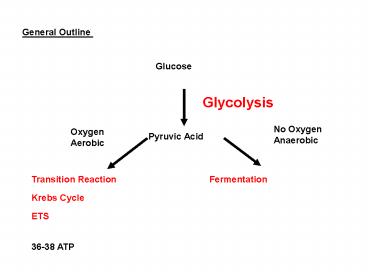tca - PowerPoint PPT Presentation
1 / 12
Title:
tca
Description:
Cellular Respiration uses oxygen and glucose to produce. Carbon dioxide, water, and ATP. ... Review: Cellular Respiration. Glycolysis: 2 ATP (substrate-level ... – PowerPoint PPT presentation
Number of Views:23
Avg rating:3.0/5.0
Title: tca
1
General Outline
Glucose
Glycolysis
No Oxygen Anaerobic
Oxygen Aerobic
Pyruvic Acid
Transition Reaction
Fermentation
Krebs Cycle
ETS
36-38 ATP
2
Steps A fuelmolecule is
energized,using ATP.
Glucose
1
3
Step
Glycolysis
1
Glucose-6-phosphate
2
Fructose-6-phosphate
Energy In 2 ATP
3
Fructose-1,6-diphosphate
Step A six-carbonintermediate splits into
two three-carbon intermediates.
4
4
Glyceraldehyde-3-phosphate (G3P)
5
Step A redoxreaction generatesNADH.
5
1,3-Diphosphoglyceric acid(2 molecules)
6
Steps ATPand pyruvic acidare produced.
3-Phosphoglyceric acid(2 molecules)
6
9
Energy Out 4 ATP
7
2-Phosphoglyceric acid(2 molecules)
8
2-Phosphoglyceric acid(2 molecules)
NET 2 ATP
9
Pyruvic acid
(2 moleculesper glucose molecule)
3
Transition Reaction
Each pyruvic acid molecule is broken down to
form CO2 and a two-carbon acetyl group, which
enters the Krebs cycle
Pyruvic Acid
Acetyl CoA
4
Krebs Cycle Where? In the Mitochondria What?
Uses Acetyl Co-A to generate ATP, NADH, FADH2,
and CO2.
5
Cellular Respiration uses oxygen and glucose to
produce Carbon dioxide, water, and ATP.
Glucose
Oxygen gas
Carbon dioxide
Water
Energy
6
Mitochondrion
Double membrane, cristae invaginations of
inner membrane
7
Reduction and Oxidation As the electrons move
from carrier to carrier, energy is released in
small quantities.
Electron transport system (ETS)
8
Krebs Cycle
9
Electron Transport System
10
Electron Transport System
For each glucose molecule that enters cellular
respiration, chemiosmosis produces up to 38 ATP
molecules
11
Generation of ATP Chemiosmosis
Cells use the energy released by falling
electrons in the ETS to pump H ions across a
membrane Uses the enzyme ATP synthase.
12
Review Cellular Respiration
- Glycolysis 2 ATP (substrate-level
phosphorylation) - Krebs Cycle 2 ATP
(substrate-level phosphorylation) - Electron transport oxidative phosphorylation
2 NADH (glycolysis) 6ATP
2 NADH (acetyl CoA) 6ATP 6 NADH
(Krebs) 18 ATP 2 FADH2 (Krebs) 4
ATP - 38 TOTAL ATP/glucose































